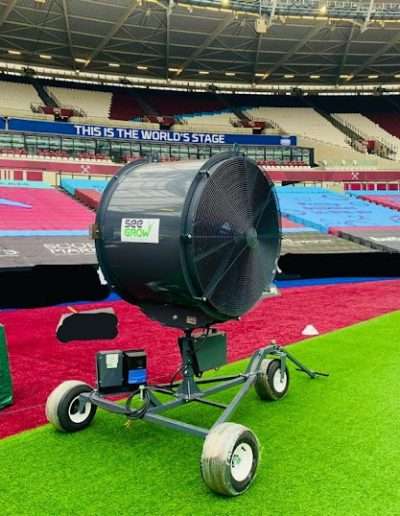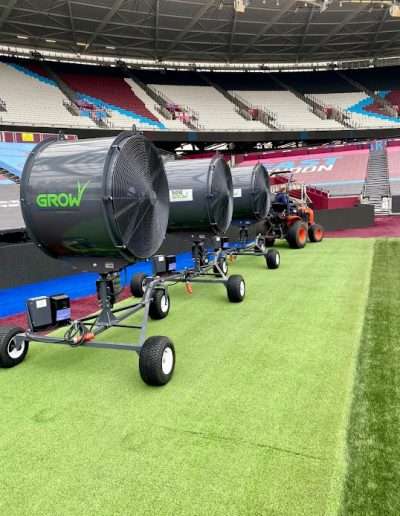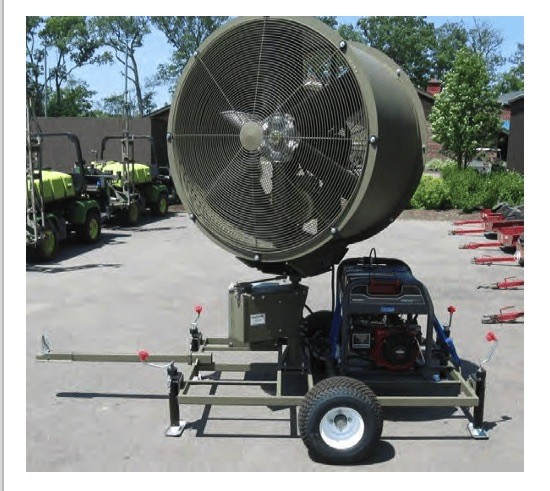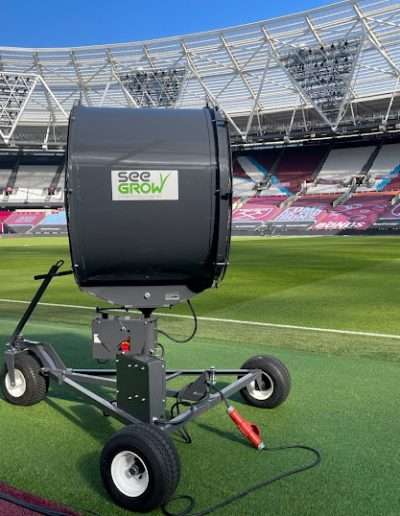TURF FANS FOR SPORTSTURF.
Turf fans for sportsturf and golf course fans, counter poor air movement, which is one of the limiting factors for optimal turf growth. The other is light.
As turf agronomists and sports turf consultants, we fully endorse turf grow lights in areas where turf is in shade. However, are you aware that you can also increase airflow by thinning out trees and removing anything limiting air movement or using sports turf fans?
When soil temperatures rise above 30°C, cool-season grasses such as bentgrass and perennial ryegrass become stressed. This stress is because they cannot cool themselves above this temperature.
As a result, there is a subsequent loss of root functionality and turf struggles. Turf fans provide much-needed air movement in areas with poor circulation and stop stress conditions from developing.
In certain situations, stresses such as high humidity will lead to the development of turf diseases like Pythium. Pythium results from reductions in evaporation, the surface remaining wetter for longer and higher turf canopy temperatures.
Indications of poor air circulation on sports turf
- The turf canopy thins out;
- The presence of algae;
- Turf diseases such as pythium or brown patch occur regularly, and
- The surface is excessively wet.
To deal with this problem, we have two solutions. Firstly, a sports ground unit (P1), and secondly, a golf course (P2) option.
In the USA, some golf courses have as many as 40 permanent fans while others have only one or two for problem greens. In stadiums, these are generally set up in banks of 8 to ensure optimal airflow.
Placement is important. Turf fans further than 10m from the surface are not likely to be of any benefit to the surface. Also, place them where they are likely to be the most beneficial, not where it’s most convenient.
Research into turf fans for sportsturf shows:
- They reduce the soil temperature and increase root length density on creeping bentgrass putting greens. Turf fans lower the surface temperature of a golf green by up to 3°C and decrease the soil temperature by 1° to 2°C.
- Turf fans reduce disease pressure due to increases in wind velocity.
- Turf fans dry the soil and reduce turf leaf wetness.
- Using turf fans improves putting green wear tolerance and
- They improve the quality of shaded greens.
- Fans lower soil temperatures and improve the root growth of creeping bentgrass during the summer even if you do not syringe.
- If you syringe during the summer and no not use turf fans it can reduce root growth.
The P1 Fan for sportsgrounds.
The design of modern stadiums is to enhance the viewing experience. Consequently, they often have poor natural air circulation. The design of the P1 Turf Fans creates an airflow to give turf grass the best conditions for optimal growth.
The P2 turf fans for sportsturf on golf courses.
Restricted air movement is one of the factors contributing to summer bentgrass decline.
More than 20 years of research have demonstrated that turf fans for sports turf improve air circulation and sustain the quality of creeping bentgrass putting greens in the summer months.
The P2 golf course Turf Fan is designed to cool golf greens, and is highly mobile with both a mains and auxiliary power option. One being adequate per green.
The video below shows how fans can lower the surface temperature of a golf green.






